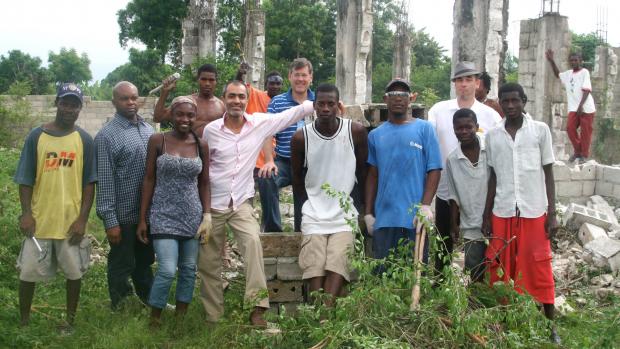Associate Professor Ghandehari’s GreenLight Innovations to Help Rebuild Haiti

Six months after an earthquake measuring 7.3 on the Richter scale devastated Haiti, only 28,000 of the 1.5 million Haitians displaced by the catastrophe had found new homes. Associate Professor [USER:177|profilelink] of NYU-Poly’s Department of Civil Engineering is working toward changing that through GreenLight Innovations, the nonprofit he’s established in response to the disaster. Together with Orphans International Worldwide (OIWW) and the We Can’t Have That Foundation (WCHTF), GreenLight is embarking on a sustainable development initiative and workforce training program that will break ground in Haiti in September.
“We know how to make a difference,” Professor Ghandehari says about the effort, “we” being a reference to engineers. “That’s part of the engineering curriculum: how to bring teams together to solve problems.”
[GALLERY:3625|left]
That collaborative spirit brought GreenLight into being. Haiti became the focus of Professor Ghandehari and his students when they wondered how sustainable community development might be possible in a country struggling to reestablish its infrastructure in the wake of a natural disaster. As the idea for GreenLight’s Haiti project began to form, Professor Ghandehari approached Assistant Professor Carl Skelton, director of NYU-Poly’s Brooklyn Experimental Media Center and its integrated digital media program. Professor Ghandehari was interested in Betaville, an online platform for collaborative planning of urban design projects Professor Skelton is creating. Professor Ghandehari thought it had potential applications in development projects in Haiti. Ironically, and helpfully, Professor Skelton was already in discussions with OIWW’s Jim Luce and WCHTF’s Evens Anozine about a separate project involving access to the Internet and post-graduate programs for schools in the city of Léogâne. He encouraged them to meet with Professor Ghandehari, and deeper roots for GreenLight in Haiti were planted through a partnership with OIWW and WCHTF.
Thinking and Acting Locally
Professor Ghandehari, who had been at work with his students on a low-cost, lightweight concrete that can absorb a great deal of energy from forces like earthquakes, found himself asking how its design could respond to the local constraints posed by post-earthquake Haiti. (Watch a student describe the concrete.) “It’s not the case that ‘anything I build in New York, I can build in Haiti,’” he says. “So how do you reconfigure your innovation so that it can be applied in different environments? That’s where engineering comes in.”
Local constraints in this case involved a community lacking equipment and sound construction skills, among other challenges. Even if GreenLight could provide a lightweight building material technology better able to withstand earthquakes, its use would be limited by the small number of Haitians properly trained in building construction, not to mention the relatively few inspectors qualified to assess the results. To address this challenge, Professor Ghandehari and [USER:183|profilelink] of NYU-Poly’s Center for Construction Management Technology are developing a curriculum to teach safe building technologies.
i2e at work in Haiti
GreenLight’s training programs will teach local laborers, including selected graduates from OIWW’s post-graduate development program, how to build an 18 x 18-feet, two-room house with 3 x 8-feet, lightweight concrete panels that Professor Ghandehari and his team of graduate students developed. The modular design makes it possible to connect multiple 18 x 18-feet units together. “You can connect and connect to make them bigger,” says the professor, “like Legos.”
Armed with such skills, trainees can quickly build the houses that are so desperately needed in Haiti and, as Professor Ghandehari hopes, eventually establish businesses that draw from their construction experience. As he’s establishing the nonprofit, Professor Ghandehari and GreenLight partners are trying to pass on entrepreneurial skills so that others can similarly practice NYU-Poly’s i2e philosophy of innovation, invention, and entrepreneurship.
It’s a trend he sees in the culture at large. “Everyone now is looking at community service,” Professor Ghandehari says. “How can you do something with your organization to reach out and make a difference right now? That’s becoming very transparent, very clear, as a mission.”
Pundits call it “social entrepreneurship,” a term used to describe the application of entrepreneurial principles to social ventures. Instead of basing profit purely on dollars, social entrepreneurship measures success in terms of the positive change wrought by the endeavor. For Professor Ghandehari, it’s simple: reviewing photos from a recent trip to the ravaged country, he says, “These people just want a roof over their heads.”
Making a Difference
Others who wish to support Professor Ghandehari and GreenLight with their mission can contact him at masoud@poly.edu or visit http://greenlightinnovations.org. He and the organization plan to break ground in September starting with the training center in the city of Léogâne, 20 miles west of Haiti’s capital Port-au-Prince. Materials and equipment to the effort have been donated and the United Nations is assisting with shipment. Green Light continues to actively seek volunteers and donors.
Related
Watch Vincenzo Ucciero, one of Professor Ghandehari's master's students who graduated in May, describe his involvement in the research GreenLight will apply in Haiti:




